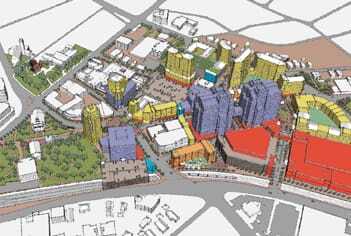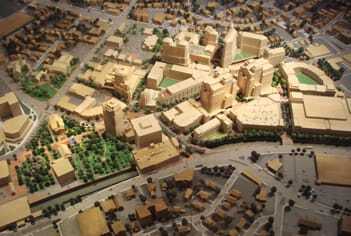In one of the oldest cities in the United States, one of the newest forms of public/private partnership is taking shape—an enterprise that could be a model for revitalizing downtowns across the county without straining public finances.
Officials in Quincy, Massachusetts, are partnering with Street-Works—a development firm that specializes in the creation of mixed-use districts around public spaces—to transform the city’s moribund central business district into a model of the future.
What’s unusual about the Quincy project is that the private sector is doing the heavy lifting—raising significant at-risk, predevelopment capital (Street-Works spent more than $18 million before it even had an agreement with the city), privately acquiring land (without eminent domain), and letting everyone know what it is doing. This is a reversal of the traditional urban development model, in which municipalities pay for public improvements before the private sector starts construction. Quincy envisions financing its infrastructure improvements through new income generated by development-specific revenue supplemented with parking garage revenues.
| Richard E. Heapes |
“Street-Works is accepting the upfront risk for permitting and building the public improvements, securing rights to all private land in the development area, guaranteeing a 4-to-1 ratio of private-to-public dollars in the overall project, and leasing tenant space in advance,” explains Richard E. Heapes, principal in White Plains, New York–based Street-Works. “Once revenues start flowing from new additional taxes and public garages, Quincy would purchase the new infrastructure from Street-Works; the city already has agreed to borrow $289 million for this. By working together, the city and Street-Works can get financing for the public improvements sooner and more easily than either party could on its own.”
What is unusual is that Quincy is not on the hook for one dime until Street-Works finishes the infrastructure. To support the new construction, the city needs new downtown utilities, roadways, sidewalks, public spaces, and eight public parking garages. Street-Works will secure interim private financing for these improvements upfront.
It’s a creative solution to a common problem, says Tom Murphy, senior resident fellow, ULI/Klingbeil Family Chair for urban development and former mayor of Pittsburgh, Pennsylvania. “Quincy is one of a number of cities that are becoming much more entrepreneurial in being extremely creative in doing public/private partnership deals,” he says. “It used to be that cities weren’t as adventurous; they were risk-adverse. But Quincy is sharing tremendous risks with the developer for significant rewards for its citizens. They’ve figured out how to finance the revitalization of their city.”
Murphy adds that banks are still reluctant to lend money for large undertakings such as Quincy’s. “That means increasing numbers of cities will be playing nontraditional roles in financing in nontraditional times,” he adds. “Cities still have access to capital through federal money as well as their own ability to float bond issues. I think the Quincy development is a good example of the public and private sectors figuring out how to do a project together with nontraditional financing. I expect to see more.”
Street-Works prefers to refer to the Quincy project as a “private/public” partnership, where the private sector leads the way and the public sector partners to make it happen. Challenges along the way have included tremendous “education” with municipal officials and the public to explain the goals and roles of the players in the process. The old ways of urban development—cities go out and purchase land, tear things down, take out a bond, and put that land out for a proposalhaven’t worked and left cities on the hook for millions, says Heapes. “We have a new paradigm in Quincy. The key to our strategy is that it’s market-driven,” he adds. “Many urban markets are underretailed, and in some cases under-officed, and in nearly all cases don’t have enough residential development. Because of the barriers of land acquisition and entitlement, there is healthy market demand in many urban places.”
Street-Works created a separate entity—Hancock Adams Associates (HAA)—to develop New Quincy Center and is the managing member. HAA will leverage the city’s many assets—the Quincy Center MBTA (Massachusetts Bay Transit Authority) station and the historic Church of the Presidents with its tremendous history to create a dynamic, mixed-use environment structured on three primary uses: commercial, retail, and residential, all connected by tree-lined sidewalks, parks, and open spaces.
The land agreement stipulates a 2015 start date for the Quincy Center project and an end date as far out as 2039. But Street-Works is targeting an aggressive schedule that would see new construction completed around 2020, with construction beginning in four years.
So confident is Heapes that Street-Works recently upped the size of the 40-acre (16.2-ha) project because of market response. It is now a $1.6 billion development with $340 million of public improvements. The program includes 700,000 square feet (65,100 sq m) of retail uses, 1,400 residential units, over 1 million square feet (92,903 sq m) of office space, and two hotels. “None of this space is being built ‘spec,’ which would not work with our economic model,” says Heapes. “As of this time, every major residential developer in Boston is pursuing us to participate in the residential program and we could lease the destination anchor retail [340,000 square feet (31,587 sq m)] two times over. The office component is getting serious consideration for education expansion and a wellness platform involving major Boston hospitals expanding out of downtown Boston to access more health care customers.”
Street-Works believes New Quincy Center could be a blueprint for other municipalities in the future. But it’s not easy. A number of factors are required for such a partnership to be successful, including a strategic vision by the public sector with strong leadership; a strong, stable history of city management with a good credit rating; a robust market for market-driven uses; and enough land to acquire without eminent domain to create critical mass to change the perception of the market.
“To create urban districts that provide the legal structure for the ‘purchase-model’ to be utilized requires the approach of performance criteria for public places and extremely flexible zoning,” says Heapes.
Downtown revitalization such as that envisioned by Street-Works necessitates planning and zoning that is more flexible and allows for a variety of market uses that could come to the site. “In our agreement with Quincy, the zoning [is] within a broad framework,” says Heapes. “It’s not parcel-by-parcel, or traffic-driven. It doesn’t prescribe exact uses for various blocks but allows [for] flexibility. The zoning is more performance-driven. It provides needed economic flexibility. Instead of the city dictating what is built, we worked together to figure it out. We developed trust, which came from the public and private sectors cooperating and figuring it out together. As a result, the private sector can build everything at once. It can be done faster and more cost-effectively. When the private sector builds infrastructure with a legislative agreement by the city to purchase it back, it gives the private sector a guaranteed take-out exit strategy, and allows a separate additional tax to be put in place to pay for that infrastructure.”
He adds that the Street-Works’ model is building a new neighborhood district, not merely one project. “You can’t do it with only public leadership or just private leadership,” he said. “It takes a true private/public partnership.”




![Western Plaza Improvements [1].jpg](https://cdn-ul.uli.org/dims4/default/15205ec/2147483647/strip/true/crop/1919x1078+0+0/resize/500x281!/quality/90/?url=https%3A%2F%2Fk2-prod-uli.s3.us-east-1.amazonaws.com%2Fbrightspot%2Fb4%2Ffa%2F5da7da1e442091ea01b5d8724354%2Fwestern-plaza-improvements-1.jpg)


